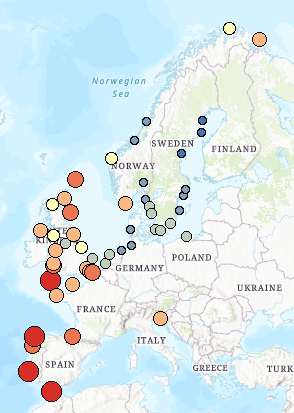flooding
Type of resources
Available actions
Topics
INSPIRE themes
Keywords
Contact for the resource
Provided by
Years
Formats
Representation types
Update frequencies
Scale
Resolution
-

This dataset represents the observed trend in maximum annual five day consecutive precipitation over Europe, between 1960 and 2015, during the winter season (December, January, February). Heavy precipitation events have become more intense and more frequent in Europe on average, but there are important differences across regions, seasons, time periods, heavy precipitation indices and underlying datasets. Studies generally agree that heavy precipitation has become more intense in northern and north-eastern Europe since the 1950s, even though not all changes are statistically significant. Different studies and indices show diverging trends for south-western and southern Europe. Heavy precipitation may lead to local surface water flooding in cities, therefore should be considered in adaptation planning. This dataset is used also in the EEA Indicator "Heavy precipitation in Europe": https://www.eea.europa.eu/data-and-maps/indicators/precipitation-extremes-in-europe-3/assessment, which in the meantime has been updated.
-

This gridded dataset represents the observed trend in maximum annual five day consecutive precipitation over Europe, between 1960 and 2015, during summer (June, July, August). Heavy precipitation events have become more intense and more frequent in Europe on average, but there are important differences across regions, seasons, time periods, heavy precipitation indices and underlying datasets. Studies generally agree that heavy precipitation has become more intense in northern and north-eastern Europe since the 1950s, even though not all changes are statistically significant. Different studies and indices show diverging trends for south-western and southern Europe. Heavy precipitation may lead to local surface water flooding in cities, therefore should be considered in adaptation planning. This dataset is used also in the EEA Indicator "Heavy precipitation in Europe": https://www.eea.europa.eu/data-and-maps/indicators/precipitation-extremes-in-europe-3/assessment, which in the meantime has been updated.
-

This dataset presents the estimated multiplication factor by which the frequency of flooding events of a given height in European tide gauges will change between 2010 and 2100, due to projected regional sea relative level rise under the Representative Concentration Pathways (RCP) 4.5 scenario. Values larger than 1 indicate an increase in flooding frequency. This dataset is derived from the Figure 13.25(b) of the Working Group I contribution to the IPCC Fifth Assessment Report (http://www.climatechange2013.org/images/report/WG1AR5_ALL_FINAL.pdf). This dataset also contributes to an earlier version of the EEA Indicator "Global and European sea-level": https://www.eea.europa.eu/data-and-maps/indicators/sea-level-rise-5/assessment.
-

The EEA potential flood prone area extent delineates the area that is flooded once every 100 years, i.e. the probability of flooding is 1% assuming that flooding is unrestricted. The potential flood prone area is comprised of the river channel and floodplain. In reality, the floodplain is split into an active floodplain where flooding still occurs, and former floodplain where flooding is restricted due to flood protection. The former floodplain could be flooded again either if a flood exceeds the capacity of flood protection, or if factors that control the presence of water were removed. These factors include channel and floodplain morphological alterations as well as structural flood protection measures. The spatial coverage of the data set is EEA39 countries.
 RUC Geo-Data catalogue
RUC Geo-Data catalogue